Foreign Aid for Health: Balancing Assistance and National Policy
VerifiedAdded on 2023/06/11
|9
|2888
|280
Essay
AI Summary
This essay critically evaluates the impact of foreign health aid on recipient countries, using Kenya and Malawi as case studies. It examines how foreign aid can provide much-needed assistance in achieving health goals, citing examples of successful programs in Kenya related to HIV/AIDS, malaria control, and community health initiatives. However, it also explores the burdens associated with managing donor requirements, the potential for donor priorities to distort national policies, and the weakening of domestic health systems, particularly in Malawi. The essay further discusses policies and approaches that can address the distortionary effects of health aid, such as tailored implementation strategies, focusing aid on the poorest countries, and using independent monitors. It concludes by referencing the successful implementation of an Aid policy in Rwanda, which has improved health system outcomes related to foreign aid by ensuring reasonable conditions and preventing financial barriers.
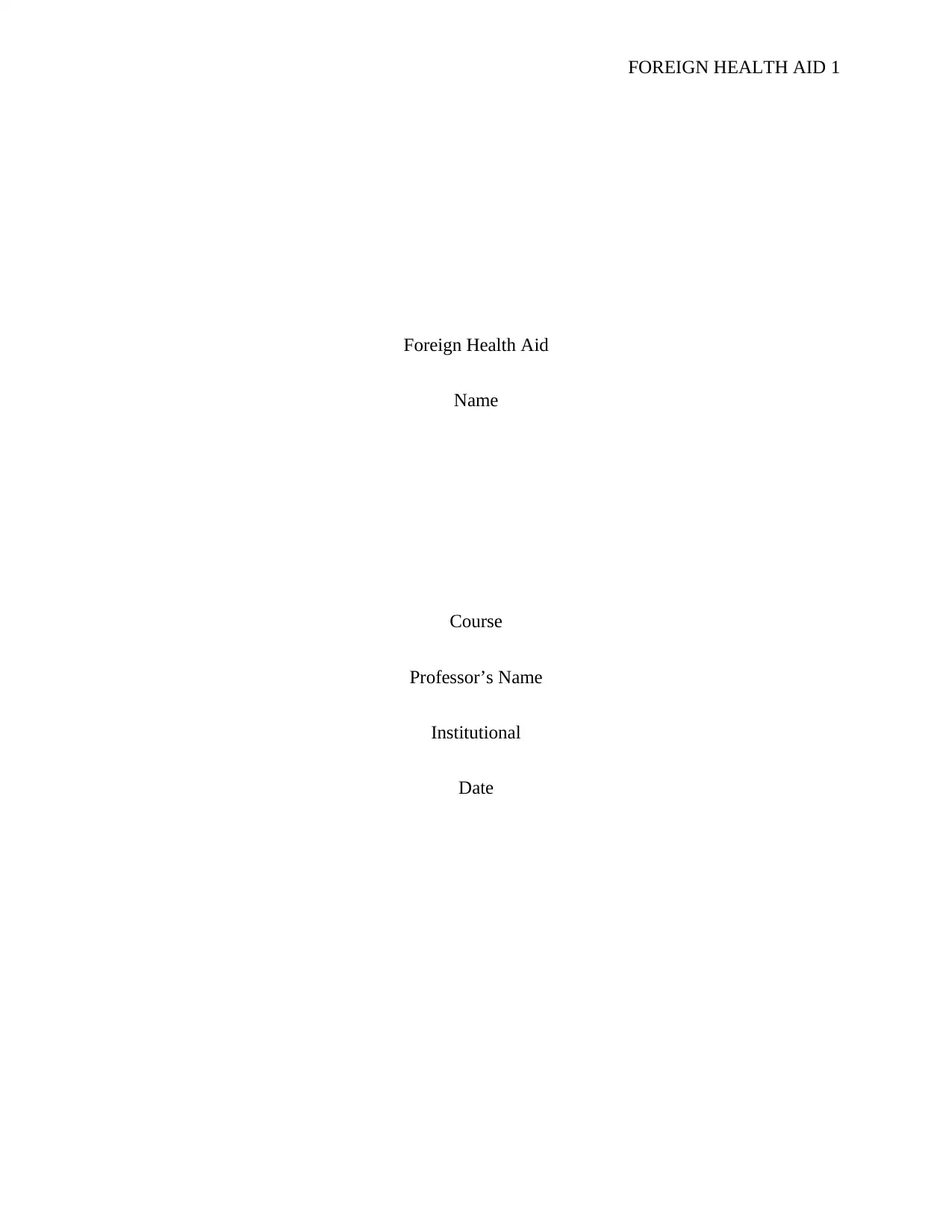
FOREIGN HEALTH AID 1
Foreign Health Aid
Name
Course
Professor’s Name
Institutional
Date
Foreign Health Aid
Name
Course
Professor’s Name
Institutional
Date
Paraphrase This Document
Need a fresh take? Get an instant paraphrase of this document with our AI Paraphraser
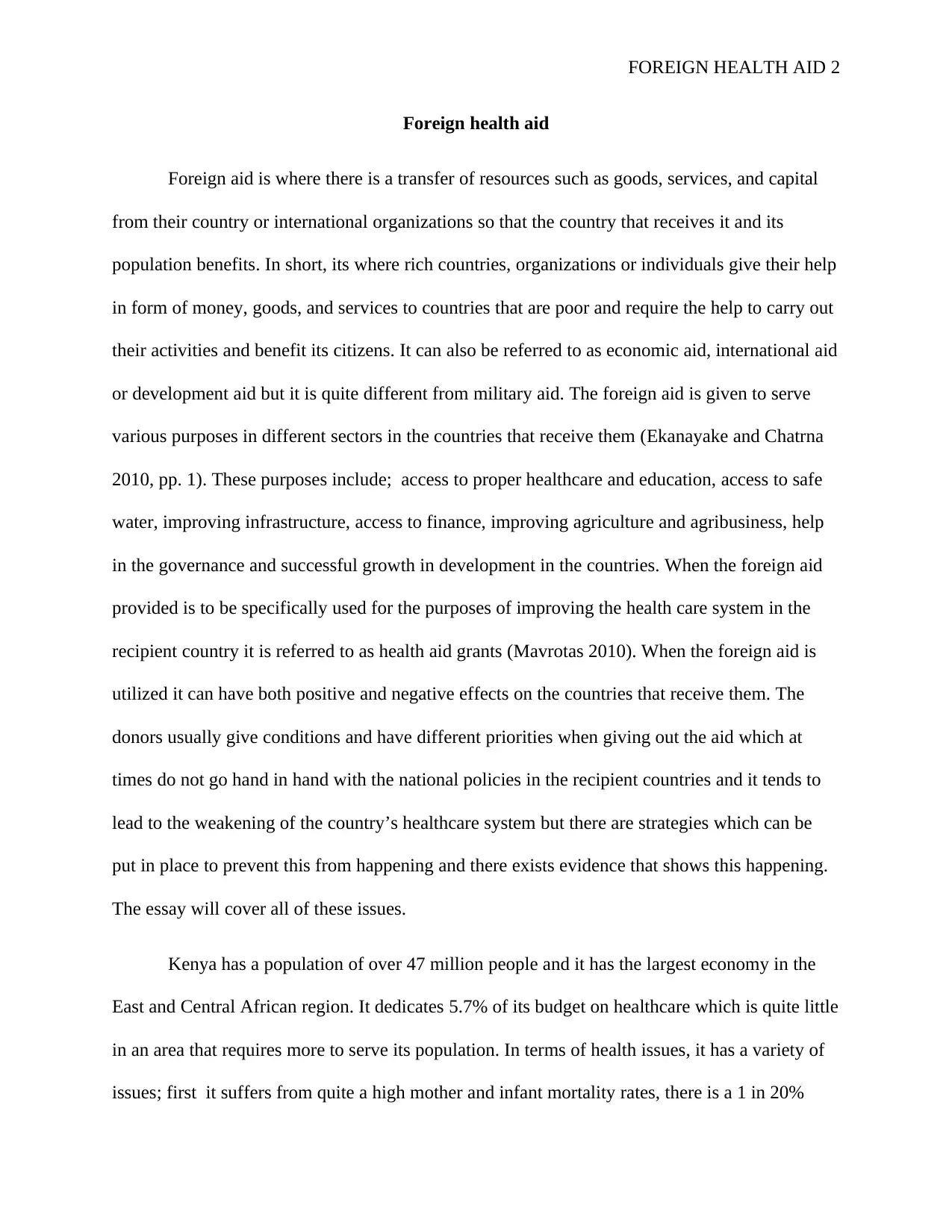
FOREIGN HEALTH AID 2
Foreign health aid
Foreign aid is where there is a transfer of resources such as goods, services, and capital
from their country or international organizations so that the country that receives it and its
population benefits. In short, its where rich countries, organizations or individuals give their help
in form of money, goods, and services to countries that are poor and require the help to carry out
their activities and benefit its citizens. It can also be referred to as economic aid, international aid
or development aid but it is quite different from military aid. The foreign aid is given to serve
various purposes in different sectors in the countries that receive them (Ekanayake and Chatrna
2010, pp. 1). These purposes include; access to proper healthcare and education, access to safe
water, improving infrastructure, access to finance, improving agriculture and agribusiness, help
in the governance and successful growth in development in the countries. When the foreign aid
provided is to be specifically used for the purposes of improving the health care system in the
recipient country it is referred to as health aid grants (Mavrotas 2010). When the foreign aid is
utilized it can have both positive and negative effects on the countries that receive them. The
donors usually give conditions and have different priorities when giving out the aid which at
times do not go hand in hand with the national policies in the recipient countries and it tends to
lead to the weakening of the country’s healthcare system but there are strategies which can be
put in place to prevent this from happening and there exists evidence that shows this happening.
The essay will cover all of these issues.
Kenya has a population of over 47 million people and it has the largest economy in the
East and Central African region. It dedicates 5.7% of its budget on healthcare which is quite little
in an area that requires more to serve its population. In terms of health issues, it has a variety of
issues; first it suffers from quite a high mother and infant mortality rates, there is a 1 in 20%
Foreign health aid
Foreign aid is where there is a transfer of resources such as goods, services, and capital
from their country or international organizations so that the country that receives it and its
population benefits. In short, its where rich countries, organizations or individuals give their help
in form of money, goods, and services to countries that are poor and require the help to carry out
their activities and benefit its citizens. It can also be referred to as economic aid, international aid
or development aid but it is quite different from military aid. The foreign aid is given to serve
various purposes in different sectors in the countries that receive them (Ekanayake and Chatrna
2010, pp. 1). These purposes include; access to proper healthcare and education, access to safe
water, improving infrastructure, access to finance, improving agriculture and agribusiness, help
in the governance and successful growth in development in the countries. When the foreign aid
provided is to be specifically used for the purposes of improving the health care system in the
recipient country it is referred to as health aid grants (Mavrotas 2010). When the foreign aid is
utilized it can have both positive and negative effects on the countries that receive them. The
donors usually give conditions and have different priorities when giving out the aid which at
times do not go hand in hand with the national policies in the recipient countries and it tends to
lead to the weakening of the country’s healthcare system but there are strategies which can be
put in place to prevent this from happening and there exists evidence that shows this happening.
The essay will cover all of these issues.
Kenya has a population of over 47 million people and it has the largest economy in the
East and Central African region. It dedicates 5.7% of its budget on healthcare which is quite little
in an area that requires more to serve its population. In terms of health issues, it has a variety of
issues; first it suffers from quite a high mother and infant mortality rates, there is a 1 in 20%
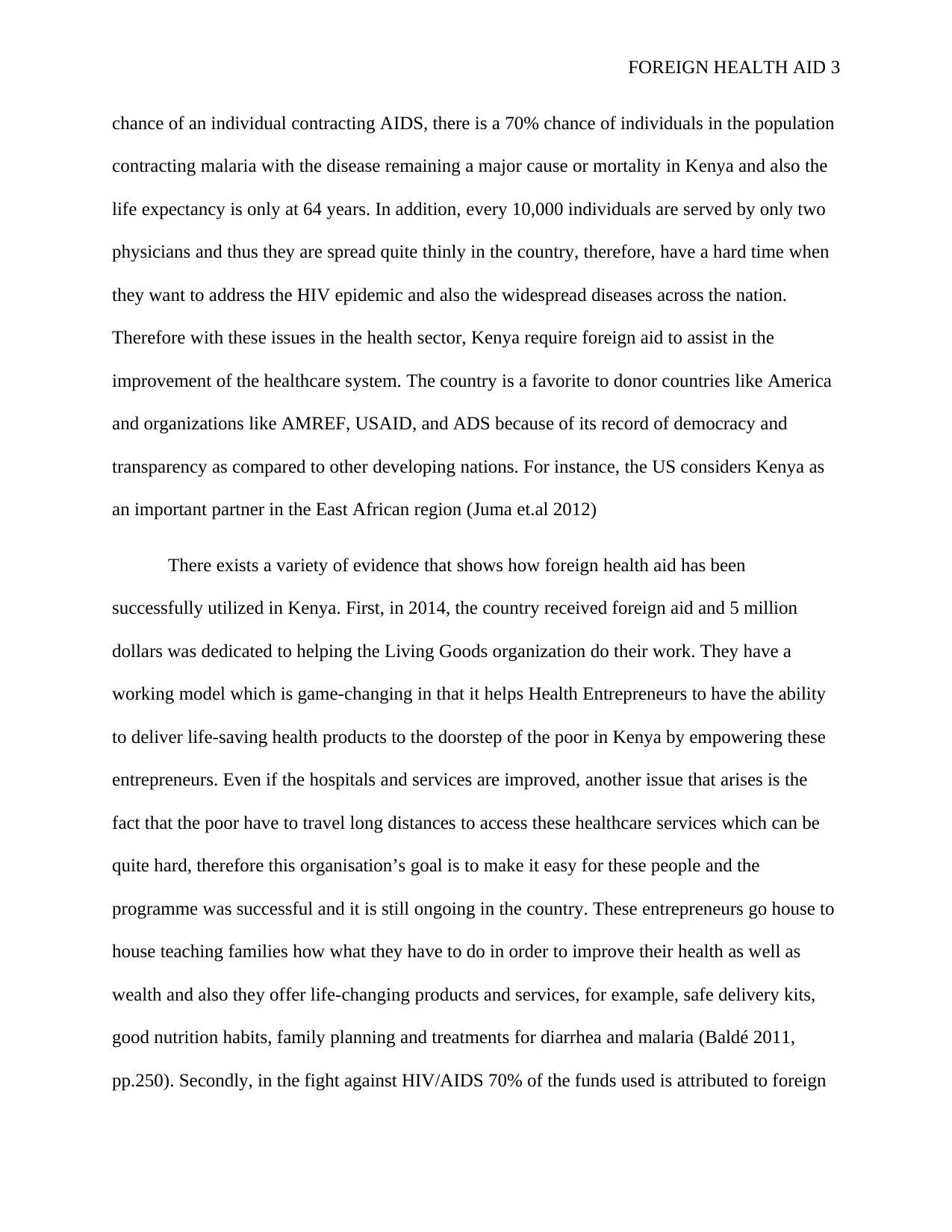
FOREIGN HEALTH AID 3
chance of an individual contracting AIDS, there is a 70% chance of individuals in the population
contracting malaria with the disease remaining a major cause or mortality in Kenya and also the
life expectancy is only at 64 years. In addition, every 10,000 individuals are served by only two
physicians and thus they are spread quite thinly in the country, therefore, have a hard time when
they want to address the HIV epidemic and also the widespread diseases across the nation.
Therefore with these issues in the health sector, Kenya require foreign aid to assist in the
improvement of the healthcare system. The country is a favorite to donor countries like America
and organizations like AMREF, USAID, and ADS because of its record of democracy and
transparency as compared to other developing nations. For instance, the US considers Kenya as
an important partner in the East African region (Juma et.al 2012)
There exists a variety of evidence that shows how foreign health aid has been
successfully utilized in Kenya. First, in 2014, the country received foreign aid and 5 million
dollars was dedicated to helping the Living Goods organization do their work. They have a
working model which is game-changing in that it helps Health Entrepreneurs to have the ability
to deliver life-saving health products to the doorstep of the poor in Kenya by empowering these
entrepreneurs. Even if the hospitals and services are improved, another issue that arises is the
fact that the poor have to travel long distances to access these healthcare services which can be
quite hard, therefore this organisation’s goal is to make it easy for these people and the
programme was successful and it is still ongoing in the country. These entrepreneurs go house to
house teaching families how what they have to do in order to improve their health as well as
wealth and also they offer life-changing products and services, for example, safe delivery kits,
good nutrition habits, family planning and treatments for diarrhea and malaria (Baldé 2011,
pp.250). Secondly, in the fight against HIV/AIDS 70% of the funds used is attributed to foreign
chance of an individual contracting AIDS, there is a 70% chance of individuals in the population
contracting malaria with the disease remaining a major cause or mortality in Kenya and also the
life expectancy is only at 64 years. In addition, every 10,000 individuals are served by only two
physicians and thus they are spread quite thinly in the country, therefore, have a hard time when
they want to address the HIV epidemic and also the widespread diseases across the nation.
Therefore with these issues in the health sector, Kenya require foreign aid to assist in the
improvement of the healthcare system. The country is a favorite to donor countries like America
and organizations like AMREF, USAID, and ADS because of its record of democracy and
transparency as compared to other developing nations. For instance, the US considers Kenya as
an important partner in the East African region (Juma et.al 2012)
There exists a variety of evidence that shows how foreign health aid has been
successfully utilized in Kenya. First, in 2014, the country received foreign aid and 5 million
dollars was dedicated to helping the Living Goods organization do their work. They have a
working model which is game-changing in that it helps Health Entrepreneurs to have the ability
to deliver life-saving health products to the doorstep of the poor in Kenya by empowering these
entrepreneurs. Even if the hospitals and services are improved, another issue that arises is the
fact that the poor have to travel long distances to access these healthcare services which can be
quite hard, therefore this organisation’s goal is to make it easy for these people and the
programme was successful and it is still ongoing in the country. These entrepreneurs go house to
house teaching families how what they have to do in order to improve their health as well as
wealth and also they offer life-changing products and services, for example, safe delivery kits,
good nutrition habits, family planning and treatments for diarrhea and malaria (Baldé 2011,
pp.250). Secondly, in the fight against HIV/AIDS 70% of the funds used is attributed to foreign
⊘ This is a preview!⊘
Do you want full access?
Subscribe today to unlock all pages.

Trusted by 1+ million students worldwide

FOREIGN HEALTH AID 4
aid. In 2000, the number of hospitals in Kenya where one could get tested and counseling for
HIV/AIDS was three but by 2010 the number stood at 4000. Also, cases of HIV/AIDS
prevalence have reduced thanks to the fact that more people can now easily access ARVs at an
affordable price the figure in 2010 stood at over 600,000 people being able to access the
medication from just 6,000 in 2003 (Luoma et.al 2010). In the country, HIV/AIDS is a
compulsory subject in school where children are given knowledge about the disease which has
led to the reduction of cases of HIV/AIDS infection. In addition, the Kenyan government also
sees voluntary male circumcision as a tool in the fight against HIV which has been proven to
reduce chances of infection by 40% in men. All of these programmes aimed at fighting HIV in
Kenya were all possible thanks to foreign health aid grants and donors which help foot the cost
(Edström and MacGregor 2010). Finally, with funds from foreign aid, Kenyan schools carried
out studies on the prevalence of malaria across the country and with these results they came up
with impact evaluation results. The Kenyan government with funds from foreign aid through the
National Malaria Strategy used these results to come up with school-based pilot interventions in
the fight against malaria with the aim to control malaria through schools and this was a
successful project as it now being expanded across the country (Gitonga et.al 2010, pp.306).
However, some countries sometimes have to bear the burden brought on foreign aid they
receive which was meant to assist them in the various areas they require help to develop but
because of a variety of reasons like conditions by the donors and conflicting policies, it has not
been successful. A country like Malawi has sheltered the burden of receiving foreign aid,
especially that is meant for the health sector. In Malawi, the leading health issues and the leading
cause of death is HIV/AIDS, malaria and also acute respiratory infections. The first burden that
Malawi has sheltered as a result of receiving foreign aid for the health sector is that they lack the
aid. In 2000, the number of hospitals in Kenya where one could get tested and counseling for
HIV/AIDS was three but by 2010 the number stood at 4000. Also, cases of HIV/AIDS
prevalence have reduced thanks to the fact that more people can now easily access ARVs at an
affordable price the figure in 2010 stood at over 600,000 people being able to access the
medication from just 6,000 in 2003 (Luoma et.al 2010). In the country, HIV/AIDS is a
compulsory subject in school where children are given knowledge about the disease which has
led to the reduction of cases of HIV/AIDS infection. In addition, the Kenyan government also
sees voluntary male circumcision as a tool in the fight against HIV which has been proven to
reduce chances of infection by 40% in men. All of these programmes aimed at fighting HIV in
Kenya were all possible thanks to foreign health aid grants and donors which help foot the cost
(Edström and MacGregor 2010). Finally, with funds from foreign aid, Kenyan schools carried
out studies on the prevalence of malaria across the country and with these results they came up
with impact evaluation results. The Kenyan government with funds from foreign aid through the
National Malaria Strategy used these results to come up with school-based pilot interventions in
the fight against malaria with the aim to control malaria through schools and this was a
successful project as it now being expanded across the country (Gitonga et.al 2010, pp.306).
However, some countries sometimes have to bear the burden brought on foreign aid they
receive which was meant to assist them in the various areas they require help to develop but
because of a variety of reasons like conditions by the donors and conflicting policies, it has not
been successful. A country like Malawi has sheltered the burden of receiving foreign aid,
especially that is meant for the health sector. In Malawi, the leading health issues and the leading
cause of death is HIV/AIDS, malaria and also acute respiratory infections. The first burden that
Malawi has sheltered as a result of receiving foreign aid for the health sector is that they lack the
Paraphrase This Document
Need a fresh take? Get an instant paraphrase of this document with our AI Paraphraser
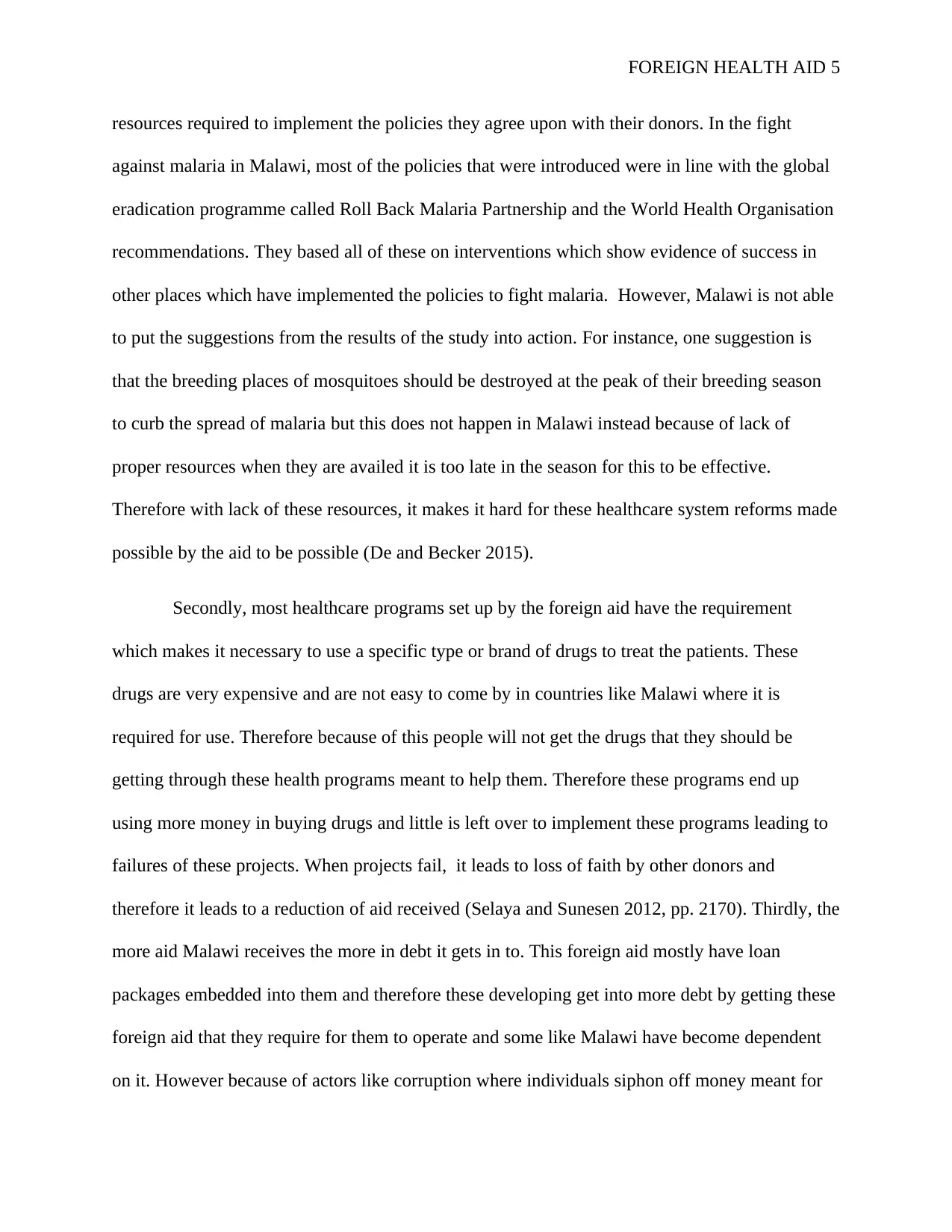
FOREIGN HEALTH AID 5
resources required to implement the policies they agree upon with their donors. In the fight
against malaria in Malawi, most of the policies that were introduced were in line with the global
eradication programme called Roll Back Malaria Partnership and the World Health Organisation
recommendations. They based all of these on interventions which show evidence of success in
other places which have implemented the policies to fight malaria. However, Malawi is not able
to put the suggestions from the results of the study into action. For instance, one suggestion is
that the breeding places of mosquitoes should be destroyed at the peak of their breeding season
to curb the spread of malaria but this does not happen in Malawi instead because of lack of
proper resources when they are availed it is too late in the season for this to be effective.
Therefore with lack of these resources, it makes it hard for these healthcare system reforms made
possible by the aid to be possible (De and Becker 2015).
Secondly, most healthcare programs set up by the foreign aid have the requirement
which makes it necessary to use a specific type or brand of drugs to treat the patients. These
drugs are very expensive and are not easy to come by in countries like Malawi where it is
required for use. Therefore because of this people will not get the drugs that they should be
getting through these health programs meant to help them. Therefore these programs end up
using more money in buying drugs and little is left over to implement these programs leading to
failures of these projects. When projects fail, it leads to loss of faith by other donors and
therefore it leads to a reduction of aid received (Selaya and Sunesen 2012, pp. 2170). Thirdly, the
more aid Malawi receives the more in debt it gets in to. This foreign aid mostly have loan
packages embedded into them and therefore these developing get into more debt by getting these
foreign aid that they require for them to operate and some like Malawi have become dependent
on it. However because of actors like corruption where individuals siphon off money meant for
resources required to implement the policies they agree upon with their donors. In the fight
against malaria in Malawi, most of the policies that were introduced were in line with the global
eradication programme called Roll Back Malaria Partnership and the World Health Organisation
recommendations. They based all of these on interventions which show evidence of success in
other places which have implemented the policies to fight malaria. However, Malawi is not able
to put the suggestions from the results of the study into action. For instance, one suggestion is
that the breeding places of mosquitoes should be destroyed at the peak of their breeding season
to curb the spread of malaria but this does not happen in Malawi instead because of lack of
proper resources when they are availed it is too late in the season for this to be effective.
Therefore with lack of these resources, it makes it hard for these healthcare system reforms made
possible by the aid to be possible (De and Becker 2015).
Secondly, most healthcare programs set up by the foreign aid have the requirement
which makes it necessary to use a specific type or brand of drugs to treat the patients. These
drugs are very expensive and are not easy to come by in countries like Malawi where it is
required for use. Therefore because of this people will not get the drugs that they should be
getting through these health programs meant to help them. Therefore these programs end up
using more money in buying drugs and little is left over to implement these programs leading to
failures of these projects. When projects fail, it leads to loss of faith by other donors and
therefore it leads to a reduction of aid received (Selaya and Sunesen 2012, pp. 2170). Thirdly, the
more aid Malawi receives the more in debt it gets in to. This foreign aid mostly have loan
packages embedded into them and therefore these developing get into more debt by getting these
foreign aid that they require for them to operate and some like Malawi have become dependent
on it. However because of actors like corruption where individuals siphon off money meant for
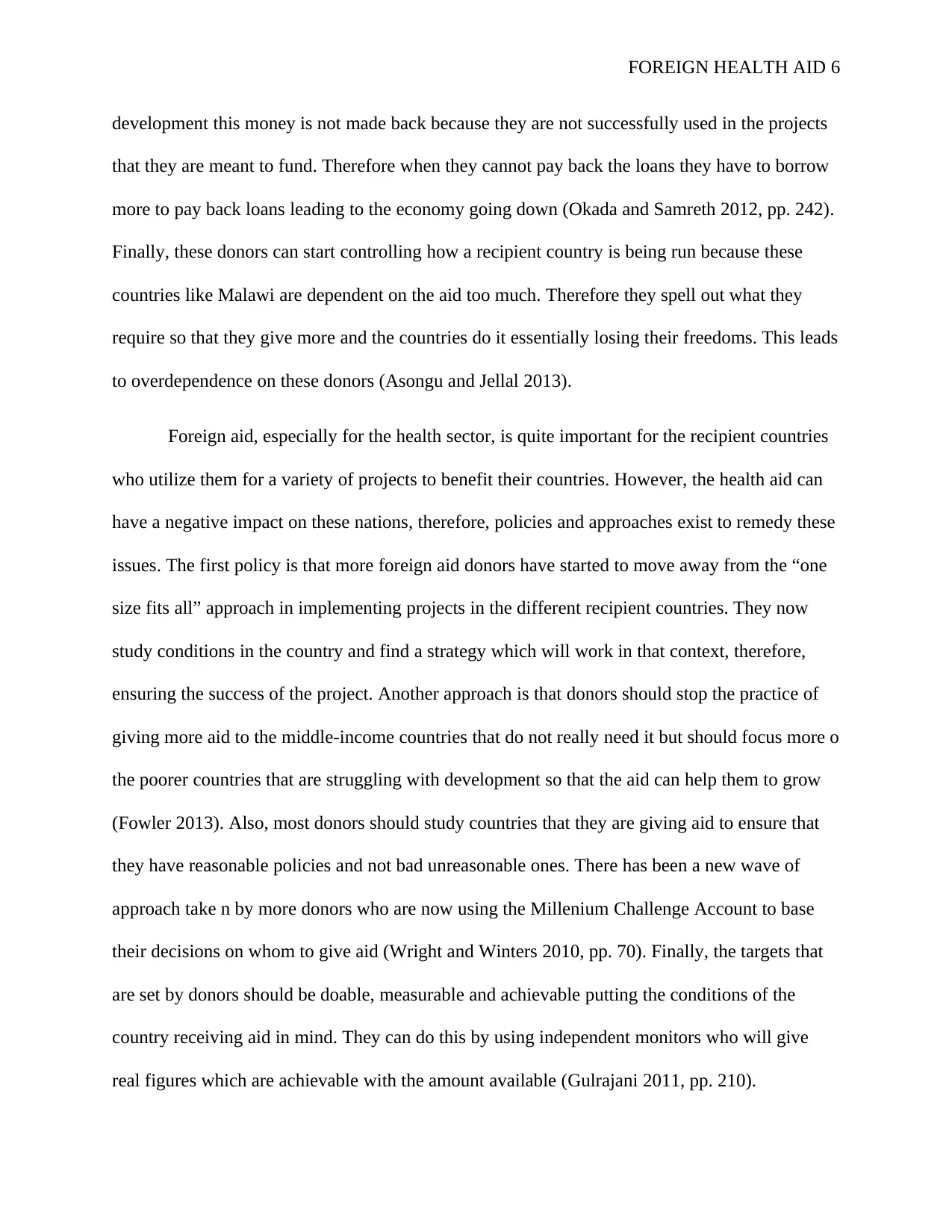
FOREIGN HEALTH AID 6
development this money is not made back because they are not successfully used in the projects
that they are meant to fund. Therefore when they cannot pay back the loans they have to borrow
more to pay back loans leading to the economy going down (Okada and Samreth 2012, pp. 242).
Finally, these donors can start controlling how a recipient country is being run because these
countries like Malawi are dependent on the aid too much. Therefore they spell out what they
require so that they give more and the countries do it essentially losing their freedoms. This leads
to overdependence on these donors (Asongu and Jellal 2013).
Foreign aid, especially for the health sector, is quite important for the recipient countries
who utilize them for a variety of projects to benefit their countries. However, the health aid can
have a negative impact on these nations, therefore, policies and approaches exist to remedy these
issues. The first policy is that more foreign aid donors have started to move away from the “one
size fits all” approach in implementing projects in the different recipient countries. They now
study conditions in the country and find a strategy which will work in that context, therefore,
ensuring the success of the project. Another approach is that donors should stop the practice of
giving more aid to the middle-income countries that do not really need it but should focus more o
the poorer countries that are struggling with development so that the aid can help them to grow
(Fowler 2013). Also, most donors should study countries that they are giving aid to ensure that
they have reasonable policies and not bad unreasonable ones. There has been a new wave of
approach take n by more donors who are now using the Millenium Challenge Account to base
their decisions on whom to give aid (Wright and Winters 2010, pp. 70). Finally, the targets that
are set by donors should be doable, measurable and achievable putting the conditions of the
country receiving aid in mind. They can do this by using independent monitors who will give
real figures which are achievable with the amount available (Gulrajani 2011, pp. 210).
development this money is not made back because they are not successfully used in the projects
that they are meant to fund. Therefore when they cannot pay back the loans they have to borrow
more to pay back loans leading to the economy going down (Okada and Samreth 2012, pp. 242).
Finally, these donors can start controlling how a recipient country is being run because these
countries like Malawi are dependent on the aid too much. Therefore they spell out what they
require so that they give more and the countries do it essentially losing their freedoms. This leads
to overdependence on these donors (Asongu and Jellal 2013).
Foreign aid, especially for the health sector, is quite important for the recipient countries
who utilize them for a variety of projects to benefit their countries. However, the health aid can
have a negative impact on these nations, therefore, policies and approaches exist to remedy these
issues. The first policy is that more foreign aid donors have started to move away from the “one
size fits all” approach in implementing projects in the different recipient countries. They now
study conditions in the country and find a strategy which will work in that context, therefore,
ensuring the success of the project. Another approach is that donors should stop the practice of
giving more aid to the middle-income countries that do not really need it but should focus more o
the poorer countries that are struggling with development so that the aid can help them to grow
(Fowler 2013). Also, most donors should study countries that they are giving aid to ensure that
they have reasonable policies and not bad unreasonable ones. There has been a new wave of
approach take n by more donors who are now using the Millenium Challenge Account to base
their decisions on whom to give aid (Wright and Winters 2010, pp. 70). Finally, the targets that
are set by donors should be doable, measurable and achievable putting the conditions of the
country receiving aid in mind. They can do this by using independent monitors who will give
real figures which are achievable with the amount available (Gulrajani 2011, pp. 210).
⊘ This is a preview!⊘
Do you want full access?
Subscribe today to unlock all pages.

Trusted by 1+ million students worldwide
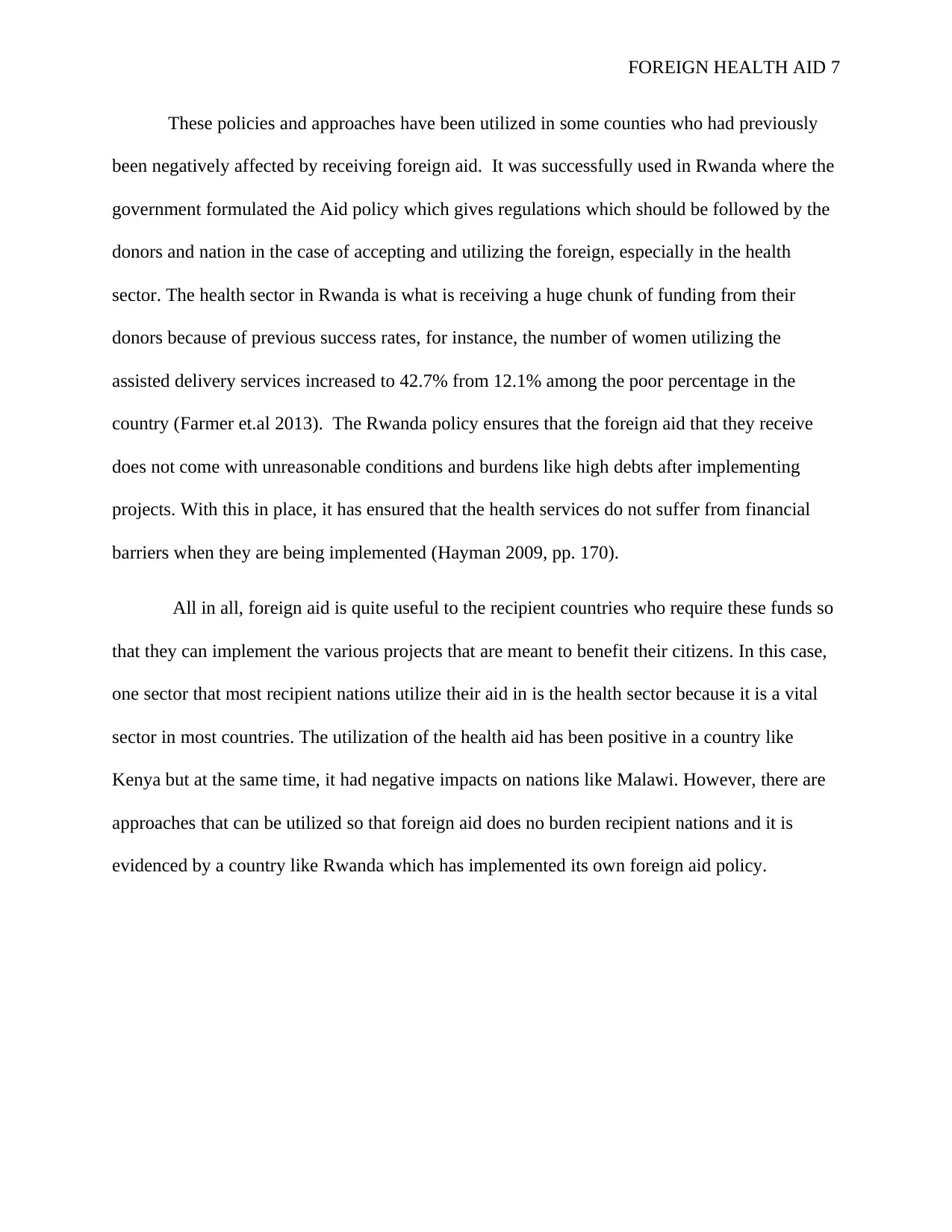
FOREIGN HEALTH AID 7
These policies and approaches have been utilized in some counties who had previously
been negatively affected by receiving foreign aid. It was successfully used in Rwanda where the
government formulated the Aid policy which gives regulations which should be followed by the
donors and nation in the case of accepting and utilizing the foreign, especially in the health
sector. The health sector in Rwanda is what is receiving a huge chunk of funding from their
donors because of previous success rates, for instance, the number of women utilizing the
assisted delivery services increased to 42.7% from 12.1% among the poor percentage in the
country (Farmer et.al 2013). The Rwanda policy ensures that the foreign aid that they receive
does not come with unreasonable conditions and burdens like high debts after implementing
projects. With this in place, it has ensured that the health services do not suffer from financial
barriers when they are being implemented (Hayman 2009, pp. 170).
All in all, foreign aid is quite useful to the recipient countries who require these funds so
that they can implement the various projects that are meant to benefit their citizens. In this case,
one sector that most recipient nations utilize their aid in is the health sector because it is a vital
sector in most countries. The utilization of the health aid has been positive in a country like
Kenya but at the same time, it had negative impacts on nations like Malawi. However, there are
approaches that can be utilized so that foreign aid does no burden recipient nations and it is
evidenced by a country like Rwanda which has implemented its own foreign aid policy.
These policies and approaches have been utilized in some counties who had previously
been negatively affected by receiving foreign aid. It was successfully used in Rwanda where the
government formulated the Aid policy which gives regulations which should be followed by the
donors and nation in the case of accepting and utilizing the foreign, especially in the health
sector. The health sector in Rwanda is what is receiving a huge chunk of funding from their
donors because of previous success rates, for instance, the number of women utilizing the
assisted delivery services increased to 42.7% from 12.1% among the poor percentage in the
country (Farmer et.al 2013). The Rwanda policy ensures that the foreign aid that they receive
does not come with unreasonable conditions and burdens like high debts after implementing
projects. With this in place, it has ensured that the health services do not suffer from financial
barriers when they are being implemented (Hayman 2009, pp. 170).
All in all, foreign aid is quite useful to the recipient countries who require these funds so
that they can implement the various projects that are meant to benefit their citizens. In this case,
one sector that most recipient nations utilize their aid in is the health sector because it is a vital
sector in most countries. The utilization of the health aid has been positive in a country like
Kenya but at the same time, it had negative impacts on nations like Malawi. However, there are
approaches that can be utilized so that foreign aid does no burden recipient nations and it is
evidenced by a country like Rwanda which has implemented its own foreign aid policy.
Paraphrase This Document
Need a fresh take? Get an instant paraphrase of this document with our AI Paraphraser
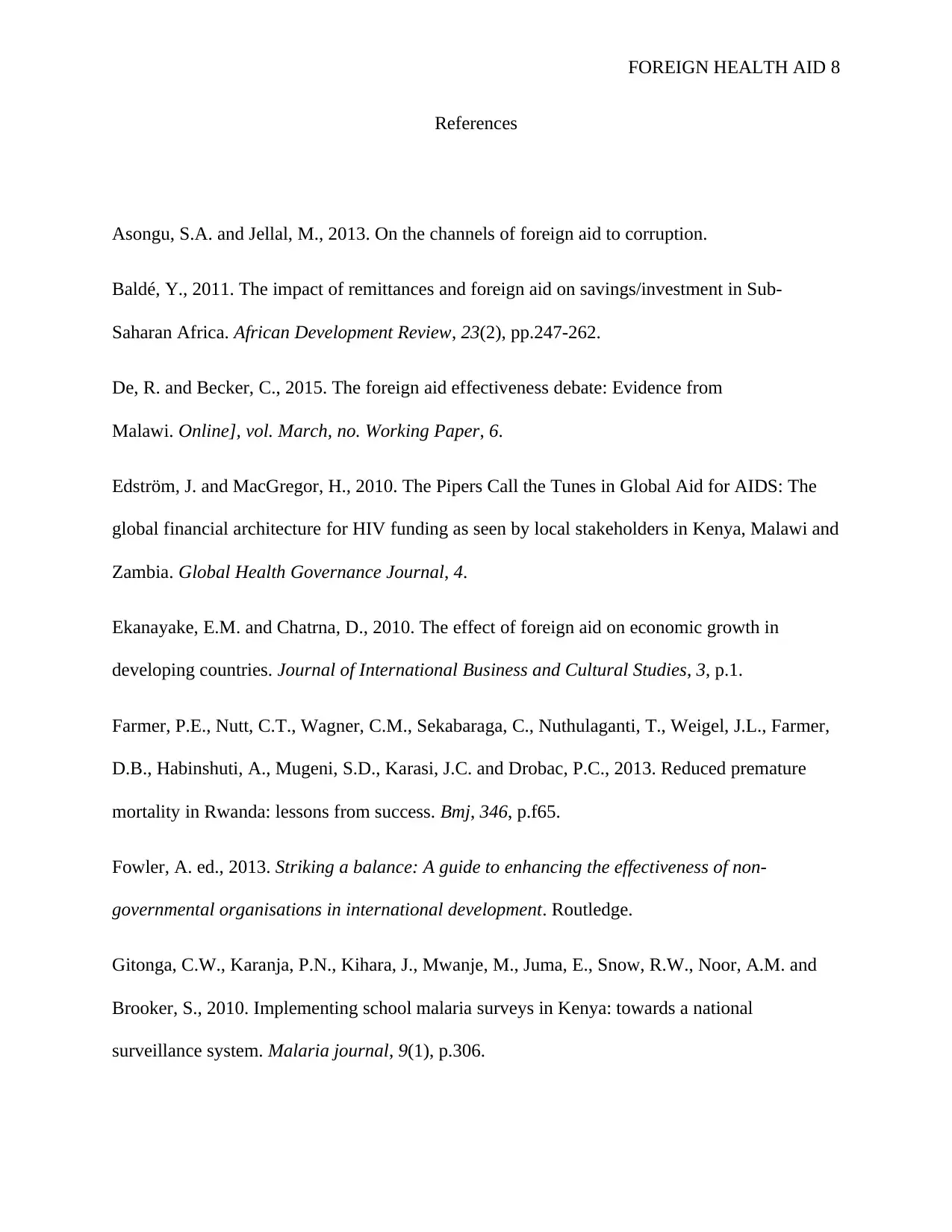
FOREIGN HEALTH AID 8
References
Asongu, S.A. and Jellal, M., 2013. On the channels of foreign aid to corruption.
Baldé, Y., 2011. The impact of remittances and foreign aid on savings/investment in Sub‐
Saharan Africa. African Development Review, 23(2), pp.247-262.
De, R. and Becker, C., 2015. The foreign aid effectiveness debate: Evidence from
Malawi. Online], vol. March, no. Working Paper, 6.
Edström, J. and MacGregor, H., 2010. The Pipers Call the Tunes in Global Aid for AIDS: The
global financial architecture for HIV funding as seen by local stakeholders in Kenya, Malawi and
Zambia. Global Health Governance Journal, 4.
Ekanayake, E.M. and Chatrna, D., 2010. The effect of foreign aid on economic growth in
developing countries. Journal of International Business and Cultural Studies, 3, p.1.
Farmer, P.E., Nutt, C.T., Wagner, C.M., Sekabaraga, C., Nuthulaganti, T., Weigel, J.L., Farmer,
D.B., Habinshuti, A., Mugeni, S.D., Karasi, J.C. and Drobac, P.C., 2013. Reduced premature
mortality in Rwanda: lessons from success. Bmj, 346, p.f65.
Fowler, A. ed., 2013. Striking a balance: A guide to enhancing the effectiveness of non-
governmental organisations in international development. Routledge.
Gitonga, C.W., Karanja, P.N., Kihara, J., Mwanje, M., Juma, E., Snow, R.W., Noor, A.M. and
Brooker, S., 2010. Implementing school malaria surveys in Kenya: towards a national
surveillance system. Malaria journal, 9(1), p.306.
References
Asongu, S.A. and Jellal, M., 2013. On the channels of foreign aid to corruption.
Baldé, Y., 2011. The impact of remittances and foreign aid on savings/investment in Sub‐
Saharan Africa. African Development Review, 23(2), pp.247-262.
De, R. and Becker, C., 2015. The foreign aid effectiveness debate: Evidence from
Malawi. Online], vol. March, no. Working Paper, 6.
Edström, J. and MacGregor, H., 2010. The Pipers Call the Tunes in Global Aid for AIDS: The
global financial architecture for HIV funding as seen by local stakeholders in Kenya, Malawi and
Zambia. Global Health Governance Journal, 4.
Ekanayake, E.M. and Chatrna, D., 2010. The effect of foreign aid on economic growth in
developing countries. Journal of International Business and Cultural Studies, 3, p.1.
Farmer, P.E., Nutt, C.T., Wagner, C.M., Sekabaraga, C., Nuthulaganti, T., Weigel, J.L., Farmer,
D.B., Habinshuti, A., Mugeni, S.D., Karasi, J.C. and Drobac, P.C., 2013. Reduced premature
mortality in Rwanda: lessons from success. Bmj, 346, p.f65.
Fowler, A. ed., 2013. Striking a balance: A guide to enhancing the effectiveness of non-
governmental organisations in international development. Routledge.
Gitonga, C.W., Karanja, P.N., Kihara, J., Mwanje, M., Juma, E., Snow, R.W., Noor, A.M. and
Brooker, S., 2010. Implementing school malaria surveys in Kenya: towards a national
surveillance system. Malaria journal, 9(1), p.306.
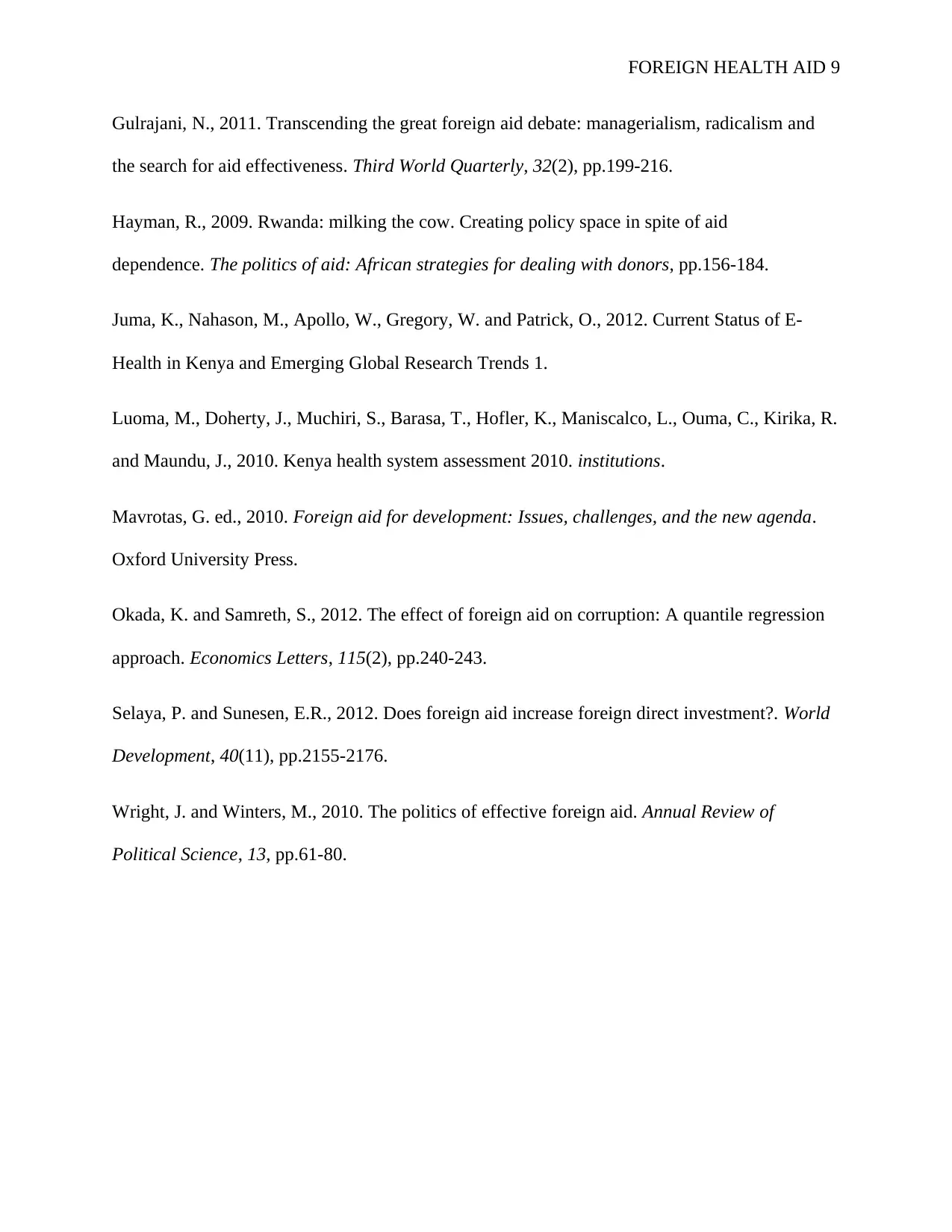
FOREIGN HEALTH AID 9
Gulrajani, N., 2011. Transcending the great foreign aid debate: managerialism, radicalism and
the search for aid effectiveness. Third World Quarterly, 32(2), pp.199-216.
Hayman, R., 2009. Rwanda: milking the cow. Creating policy space in spite of aid
dependence. The politics of aid: African strategies for dealing with donors, pp.156-184.
Juma, K., Nahason, M., Apollo, W., Gregory, W. and Patrick, O., 2012. Current Status of E-
Health in Kenya and Emerging Global Research Trends 1.
Luoma, M., Doherty, J., Muchiri, S., Barasa, T., Hofler, K., Maniscalco, L., Ouma, C., Kirika, R.
and Maundu, J., 2010. Kenya health system assessment 2010. institutions.
Mavrotas, G. ed., 2010. Foreign aid for development: Issues, challenges, and the new agenda.
Oxford University Press.
Okada, K. and Samreth, S., 2012. The effect of foreign aid on corruption: A quantile regression
approach. Economics Letters, 115(2), pp.240-243.
Selaya, P. and Sunesen, E.R., 2012. Does foreign aid increase foreign direct investment?. World
Development, 40(11), pp.2155-2176.
Wright, J. and Winters, M., 2010. The politics of effective foreign aid. Annual Review of
Political Science, 13, pp.61-80.
Gulrajani, N., 2011. Transcending the great foreign aid debate: managerialism, radicalism and
the search for aid effectiveness. Third World Quarterly, 32(2), pp.199-216.
Hayman, R., 2009. Rwanda: milking the cow. Creating policy space in spite of aid
dependence. The politics of aid: African strategies for dealing with donors, pp.156-184.
Juma, K., Nahason, M., Apollo, W., Gregory, W. and Patrick, O., 2012. Current Status of E-
Health in Kenya and Emerging Global Research Trends 1.
Luoma, M., Doherty, J., Muchiri, S., Barasa, T., Hofler, K., Maniscalco, L., Ouma, C., Kirika, R.
and Maundu, J., 2010. Kenya health system assessment 2010. institutions.
Mavrotas, G. ed., 2010. Foreign aid for development: Issues, challenges, and the new agenda.
Oxford University Press.
Okada, K. and Samreth, S., 2012. The effect of foreign aid on corruption: A quantile regression
approach. Economics Letters, 115(2), pp.240-243.
Selaya, P. and Sunesen, E.R., 2012. Does foreign aid increase foreign direct investment?. World
Development, 40(11), pp.2155-2176.
Wright, J. and Winters, M., 2010. The politics of effective foreign aid. Annual Review of
Political Science, 13, pp.61-80.
⊘ This is a preview!⊘
Do you want full access?
Subscribe today to unlock all pages.

Trusted by 1+ million students worldwide
1 out of 9
Related Documents
Your All-in-One AI-Powered Toolkit for Academic Success.
+13062052269
info@desklib.com
Available 24*7 on WhatsApp / Email
![[object Object]](/_next/static/media/star-bottom.7253800d.svg)
Unlock your academic potential
Copyright © 2020–2025 A2Z Services. All Rights Reserved. Developed and managed by ZUCOL.




